Consumer Rights Act 2015 Breaches: A Legal Analysis of Arthur's Case
VerifiedAdded on 2024/06/04
|10
|1876
|212
Report
AI Summary
This report examines the application of the Consumer Rights Act 2015 to a case involving a consumer named Arthur, who purchased goods from Homespace Ltd. The report identifies potential breaches of implied terms under the Act, focusing on whether the goods met the required standards of quality, fitness for purpose, and соответствие to description. It explores Arthur's rights as a consumer, including the right to reject faulty goods within 30 days and claim a refund or replacement. Furthermore, the report assesses the validity of a notice in the shop stating that goods once sold cannot be returned, arguing that such a notice is invalid under the Consumer Rights Act 2015. The analysis draws upon relevant legal provisions and case law to provide a comprehensive understanding of consumer rights and available remedies in similar situations.
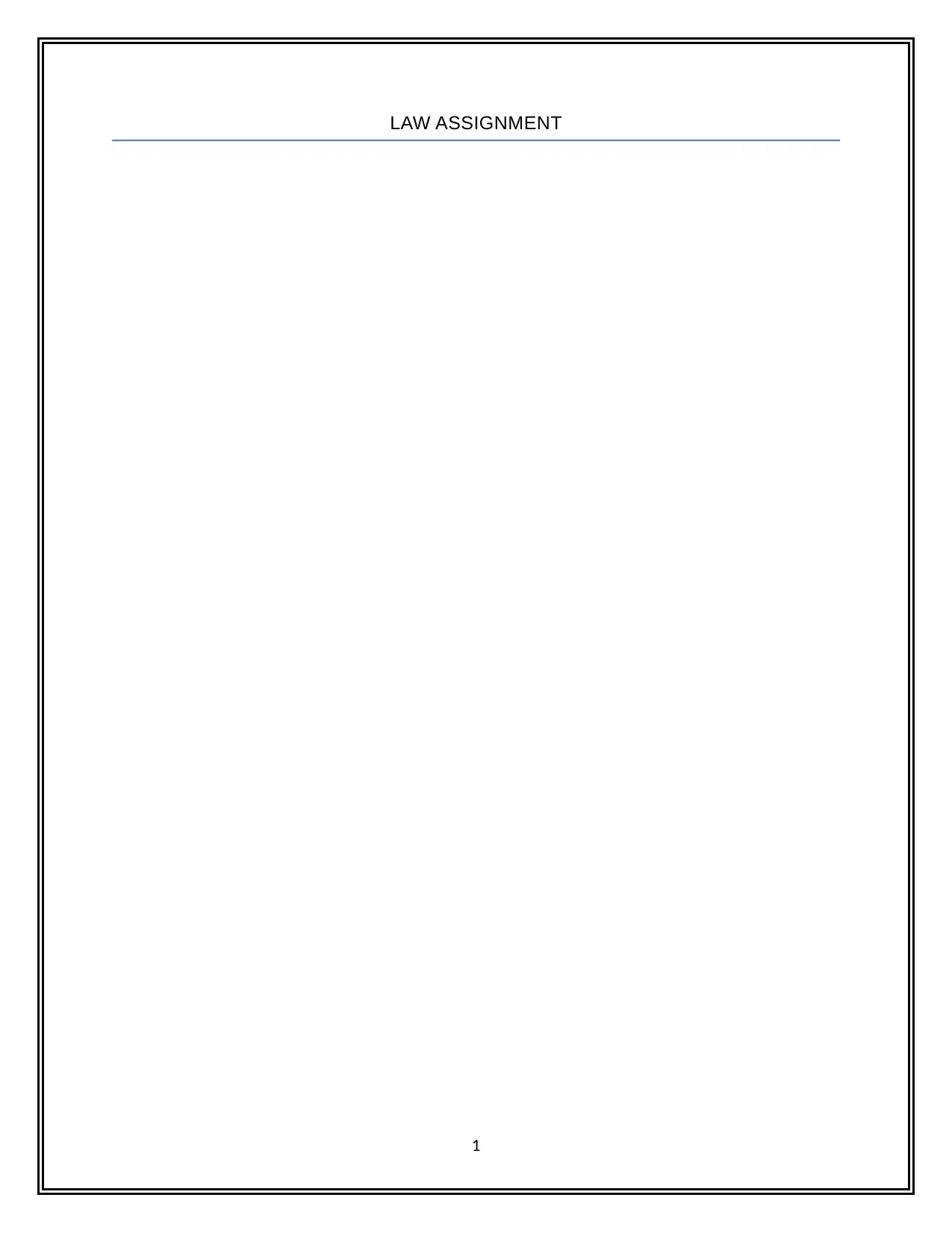
LAW ASSIGNMENT
1
1
Paraphrase This Document
Need a fresh take? Get an instant paraphrase of this document with our AI Paraphraser

Table of Contents
Introduction........................................................................................................................2
1. Discuss to what extent the terms implied by the Consumer Rights Act 2015 have
been breached and what possible remedies might be available to Arthur....................3
2. Is the notice that Arthur saw in the shop valid?.............................................................6
Conclusion.........................................................................................................................8
References.........................................................................................................................9
2
Introduction........................................................................................................................2
1. Discuss to what extent the terms implied by the Consumer Rights Act 2015 have
been breached and what possible remedies might be available to Arthur....................3
2. Is the notice that Arthur saw in the shop valid?.............................................................6
Conclusion.........................................................................................................................8
References.........................................................................................................................9
2
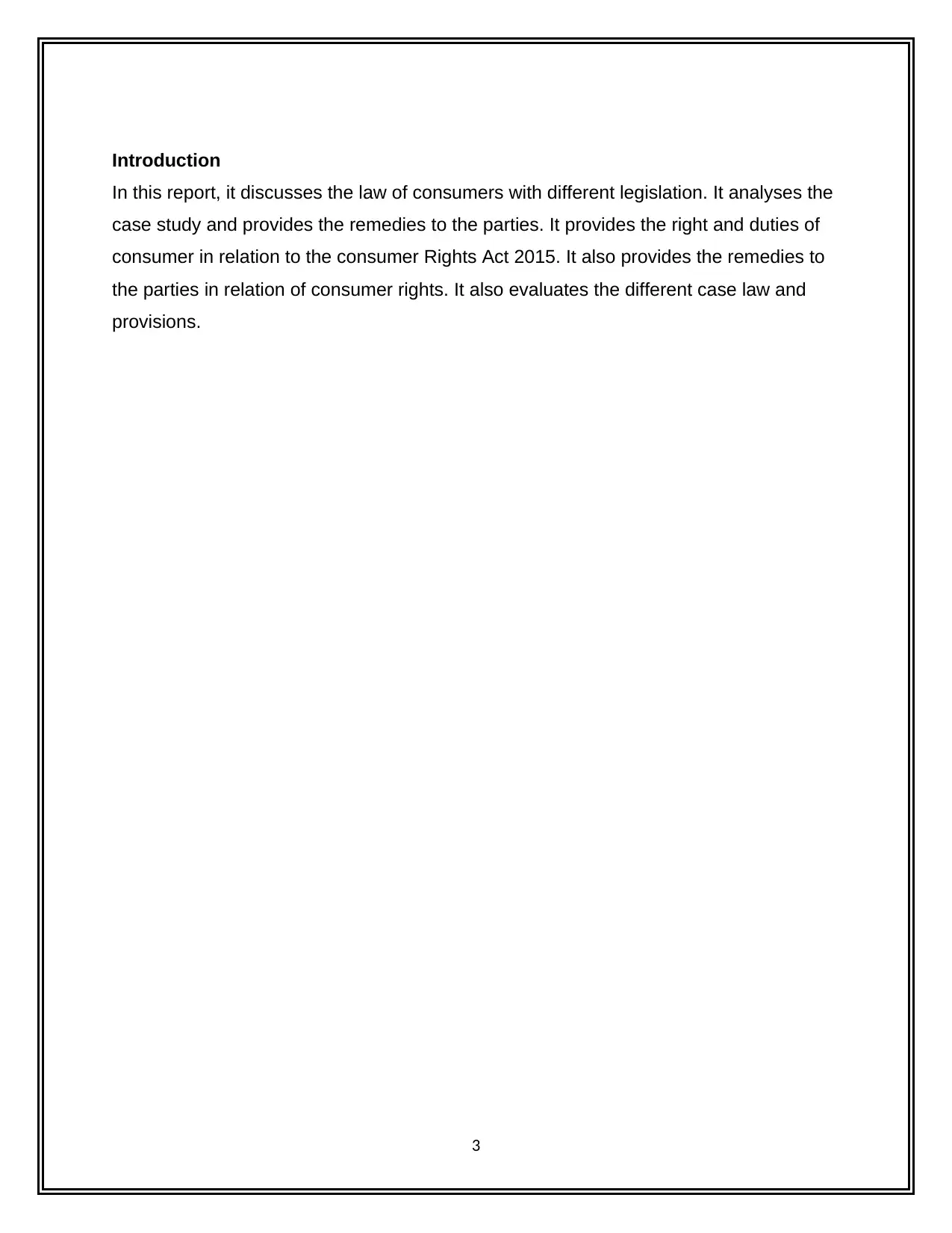
Introduction
In this report, it discusses the law of consumers with different legislation. It analyses the
case study and provides the remedies to the parties. It provides the right and duties of
consumer in relation to the consumer Rights Act 2015. It also provides the remedies to
the parties in relation of consumer rights. It also evaluates the different case law and
provisions.
3
In this report, it discusses the law of consumers with different legislation. It analyses the
case study and provides the remedies to the parties. It provides the right and duties of
consumer in relation to the consumer Rights Act 2015. It also provides the remedies to
the parties in relation of consumer rights. It also evaluates the different case law and
provisions.
3
⊘ This is a preview!⊘
Do you want full access?
Subscribe today to unlock all pages.

Trusted by 1+ million students worldwide
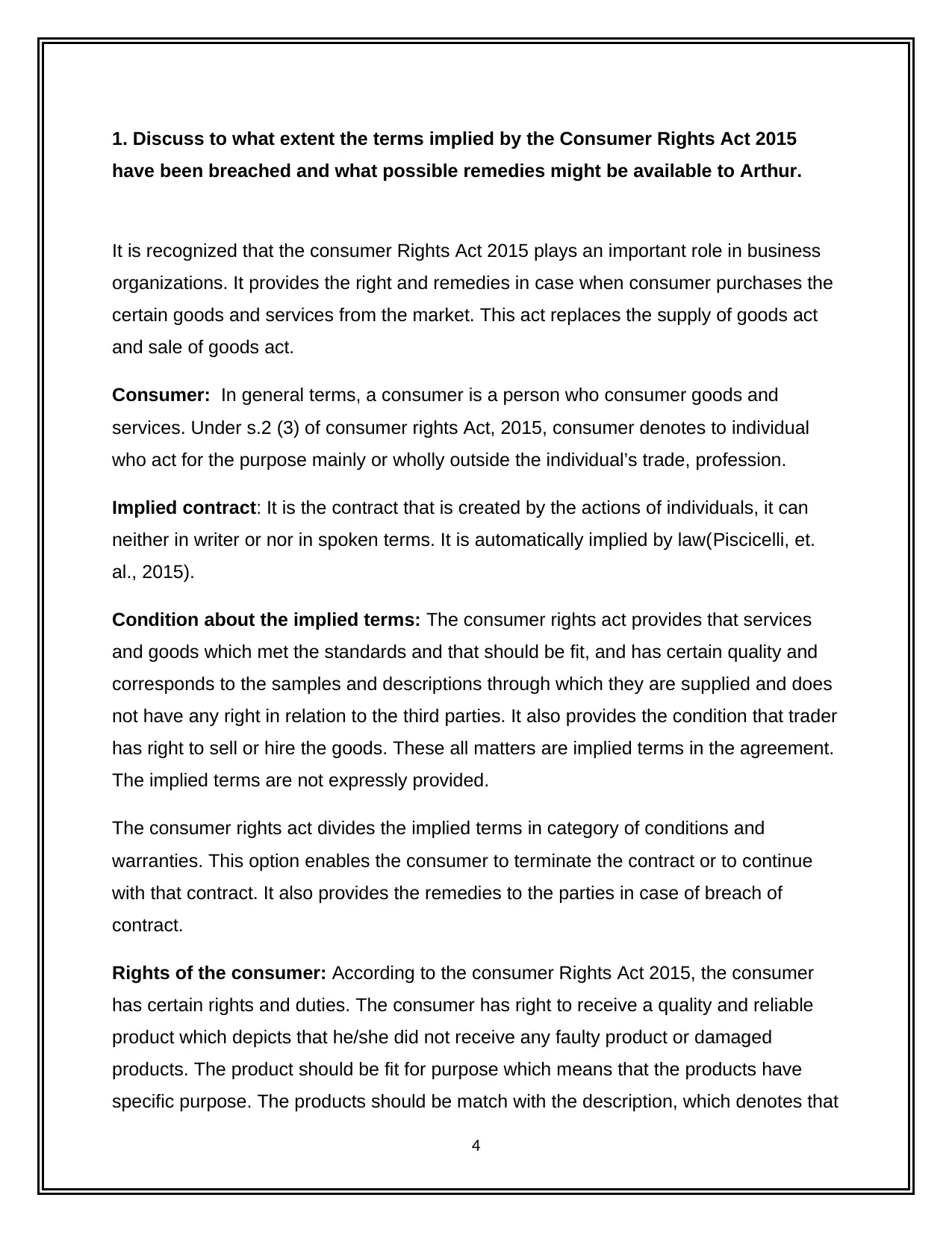
1. Discuss to what extent the terms implied by the Consumer Rights Act 2015
have been breached and what possible remedies might be available to Arthur.
It is recognized that the consumer Rights Act 2015 plays an important role in business
organizations. It provides the right and remedies in case when consumer purchases the
certain goods and services from the market. This act replaces the supply of goods act
and sale of goods act.
Consumer: In general terms, a consumer is a person who consumer goods and
services. Under s.2 (3) of consumer rights Act, 2015, consumer denotes to individual
who act for the purpose mainly or wholly outside the individual’s trade, profession.
Implied contract: It is the contract that is created by the actions of individuals, it can
neither in writer or nor in spoken terms. It is automatically implied by law(Piscicelli, et.
al., 2015).
Condition about the implied terms: The consumer rights act provides that services
and goods which met the standards and that should be fit, and has certain quality and
corresponds to the samples and descriptions through which they are supplied and does
not have any right in relation to the third parties. It also provides the condition that trader
has right to sell or hire the goods. These all matters are implied terms in the agreement.
The implied terms are not expressly provided.
The consumer rights act divides the implied terms in category of conditions and
warranties. This option enables the consumer to terminate the contract or to continue
with that contract. It also provides the remedies to the parties in case of breach of
contract.
Rights of the consumer: According to the consumer Rights Act 2015, the consumer
has certain rights and duties. The consumer has right to receive a quality and reliable
product which depicts that he/she did not receive any faulty product or damaged
products. The product should be fit for purpose which means that the products have
specific purpose. The products should be match with the description, which denotes that
4
have been breached and what possible remedies might be available to Arthur.
It is recognized that the consumer Rights Act 2015 plays an important role in business
organizations. It provides the right and remedies in case when consumer purchases the
certain goods and services from the market. This act replaces the supply of goods act
and sale of goods act.
Consumer: In general terms, a consumer is a person who consumer goods and
services. Under s.2 (3) of consumer rights Act, 2015, consumer denotes to individual
who act for the purpose mainly or wholly outside the individual’s trade, profession.
Implied contract: It is the contract that is created by the actions of individuals, it can
neither in writer or nor in spoken terms. It is automatically implied by law(Piscicelli, et.
al., 2015).
Condition about the implied terms: The consumer rights act provides that services
and goods which met the standards and that should be fit, and has certain quality and
corresponds to the samples and descriptions through which they are supplied and does
not have any right in relation to the third parties. It also provides the condition that trader
has right to sell or hire the goods. These all matters are implied terms in the agreement.
The implied terms are not expressly provided.
The consumer rights act divides the implied terms in category of conditions and
warranties. This option enables the consumer to terminate the contract or to continue
with that contract. It also provides the remedies to the parties in case of breach of
contract.
Rights of the consumer: According to the consumer Rights Act 2015, the consumer
has certain rights and duties. The consumer has right to receive a quality and reliable
product which depicts that he/she did not receive any faulty product or damaged
products. The product should be fit for purpose which means that the products have
specific purpose. The products should be match with the description, which denotes that
4
Paraphrase This Document
Need a fresh take? Get an instant paraphrase of this document with our AI Paraphraser
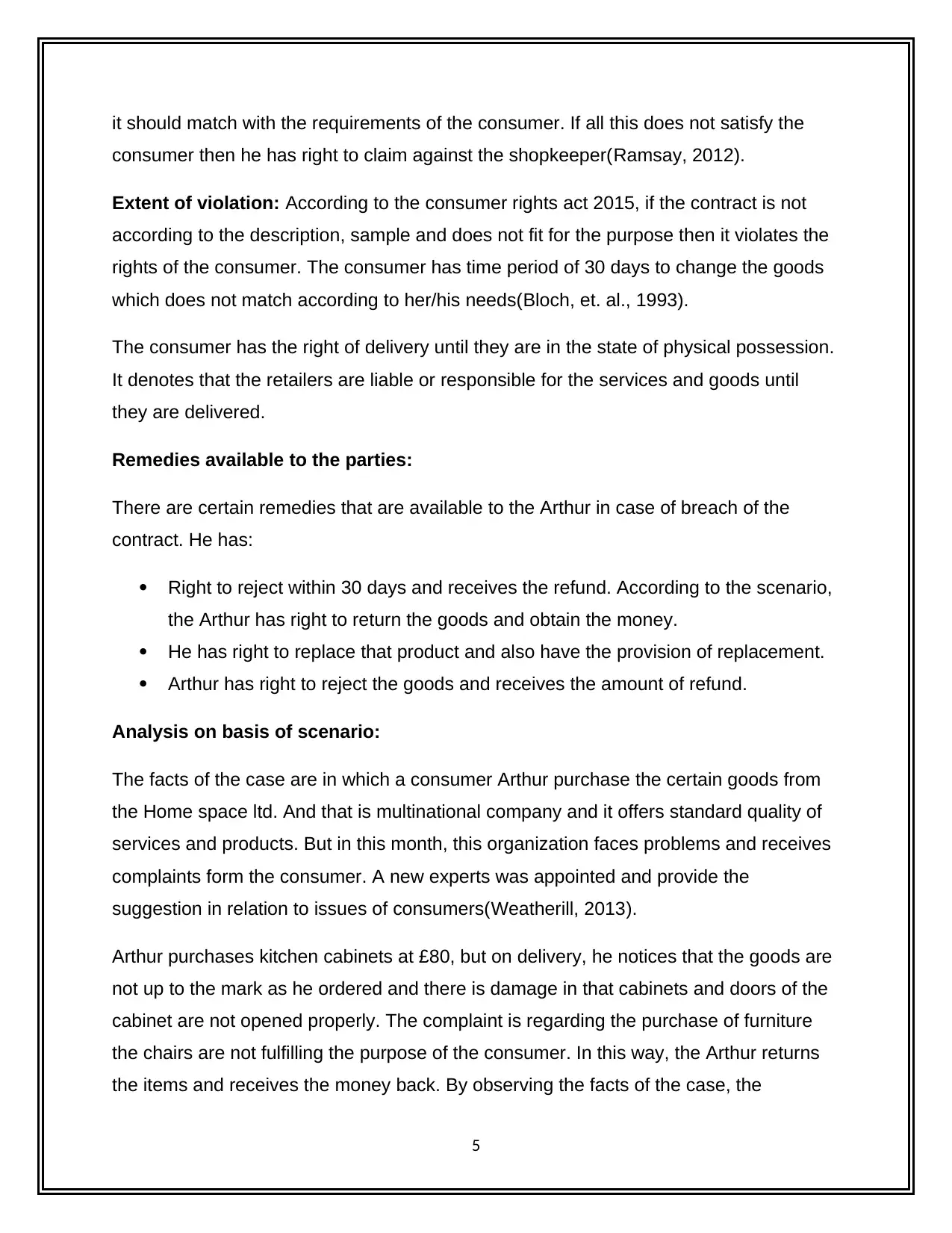
it should match with the requirements of the consumer. If all this does not satisfy the
consumer then he has right to claim against the shopkeeper(Ramsay, 2012).
Extent of violation: According to the consumer rights act 2015, if the contract is not
according to the description, sample and does not fit for the purpose then it violates the
rights of the consumer. The consumer has time period of 30 days to change the goods
which does not match according to her/his needs(Bloch, et. al., 1993).
The consumer has the right of delivery until they are in the state of physical possession.
It denotes that the retailers are liable or responsible for the services and goods until
they are delivered.
Remedies available to the parties:
There are certain remedies that are available to the Arthur in case of breach of the
contract. He has:
Right to reject within 30 days and receives the refund. According to the scenario,
the Arthur has right to return the goods and obtain the money.
He has right to replace that product and also have the provision of replacement.
Arthur has right to reject the goods and receives the amount of refund.
Analysis on basis of scenario:
The facts of the case are in which a consumer Arthur purchase the certain goods from
the Home space ltd. And that is multinational company and it offers standard quality of
services and products. But in this month, this organization faces problems and receives
complaints form the consumer. A new experts was appointed and provide the
suggestion in relation to issues of consumers(Weatherill, 2013).
Arthur purchases kitchen cabinets at £80, but on delivery, he notices that the goods are
not up to the mark as he ordered and there is damage in that cabinets and doors of the
cabinet are not opened properly. The complaint is regarding the purchase of furniture
the chairs are not fulfilling the purpose of the consumer. In this way, the Arthur returns
the items and receives the money back. By observing the facts of the case, the
5
consumer then he has right to claim against the shopkeeper(Ramsay, 2012).
Extent of violation: According to the consumer rights act 2015, if the contract is not
according to the description, sample and does not fit for the purpose then it violates the
rights of the consumer. The consumer has time period of 30 days to change the goods
which does not match according to her/his needs(Bloch, et. al., 1993).
The consumer has the right of delivery until they are in the state of physical possession.
It denotes that the retailers are liable or responsible for the services and goods until
they are delivered.
Remedies available to the parties:
There are certain remedies that are available to the Arthur in case of breach of the
contract. He has:
Right to reject within 30 days and receives the refund. According to the scenario,
the Arthur has right to return the goods and obtain the money.
He has right to replace that product and also have the provision of replacement.
Arthur has right to reject the goods and receives the amount of refund.
Analysis on basis of scenario:
The facts of the case are in which a consumer Arthur purchase the certain goods from
the Home space ltd. And that is multinational company and it offers standard quality of
services and products. But in this month, this organization faces problems and receives
complaints form the consumer. A new experts was appointed and provide the
suggestion in relation to issues of consumers(Weatherill, 2013).
Arthur purchases kitchen cabinets at £80, but on delivery, he notices that the goods are
not up to the mark as he ordered and there is damage in that cabinets and doors of the
cabinet are not opened properly. The complaint is regarding the purchase of furniture
the chairs are not fulfilling the purpose of the consumer. In this way, the Arthur returns
the items and receives the money back. By observing the facts of the case, the
5

consumer has certain rights in relation to the consumer rights act 2015. Arthur has right
to receive the quality product and that must be fit for the purpose, he has right to return
that product within 30 days. If the contract is not according to the implied terms then
there will be breach of contract. Arthur has certain remedies in relation to the
goods(Bridge, 2012).
6
to receive the quality product and that must be fit for the purpose, he has right to return
that product within 30 days. If the contract is not according to the implied terms then
there will be breach of contract. Arthur has certain remedies in relation to the
goods(Bridge, 2012).
6
⊘ This is a preview!⊘
Do you want full access?
Subscribe today to unlock all pages.

Trusted by 1+ million students worldwide
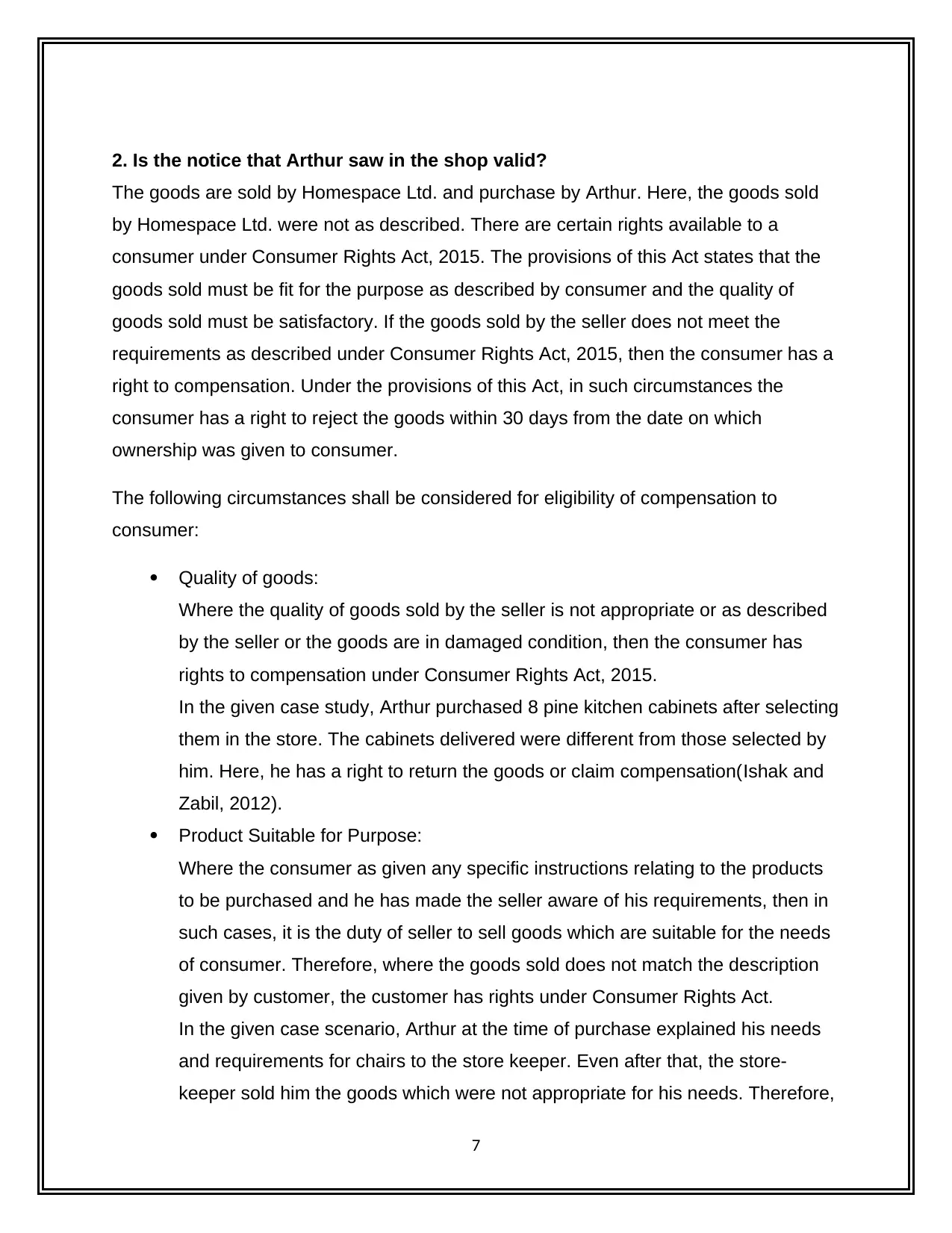
2. Is the notice that Arthur saw in the shop valid?
The goods are sold by Homespace Ltd. and purchase by Arthur. Here, the goods sold
by Homespace Ltd. were not as described. There are certain rights available to a
consumer under Consumer Rights Act, 2015. The provisions of this Act states that the
goods sold must be fit for the purpose as described by consumer and the quality of
goods sold must be satisfactory. If the goods sold by the seller does not meet the
requirements as described under Consumer Rights Act, 2015, then the consumer has a
right to compensation. Under the provisions of this Act, in such circumstances the
consumer has a right to reject the goods within 30 days from the date on which
ownership was given to consumer.
The following circumstances shall be considered for eligibility of compensation to
consumer:
Quality of goods:
Where the quality of goods sold by the seller is not appropriate or as described
by the seller or the goods are in damaged condition, then the consumer has
rights to compensation under Consumer Rights Act, 2015.
In the given case study, Arthur purchased 8 pine kitchen cabinets after selecting
them in the store. The cabinets delivered were different from those selected by
him. Here, he has a right to return the goods or claim compensation(Ishak and
Zabil, 2012).
Product Suitable for Purpose:
Where the consumer as given any specific instructions relating to the products
to be purchased and he has made the seller aware of his requirements, then in
such cases, it is the duty of seller to sell goods which are suitable for the needs
of consumer. Therefore, where the goods sold does not match the description
given by customer, the customer has rights under Consumer Rights Act.
In the given case scenario, Arthur at the time of purchase explained his needs
and requirements for chairs to the store keeper. Even after that, the store-
keeper sold him the goods which were not appropriate for his needs. Therefore,
7
The goods are sold by Homespace Ltd. and purchase by Arthur. Here, the goods sold
by Homespace Ltd. were not as described. There are certain rights available to a
consumer under Consumer Rights Act, 2015. The provisions of this Act states that the
goods sold must be fit for the purpose as described by consumer and the quality of
goods sold must be satisfactory. If the goods sold by the seller does not meet the
requirements as described under Consumer Rights Act, 2015, then the consumer has a
right to compensation. Under the provisions of this Act, in such circumstances the
consumer has a right to reject the goods within 30 days from the date on which
ownership was given to consumer.
The following circumstances shall be considered for eligibility of compensation to
consumer:
Quality of goods:
Where the quality of goods sold by the seller is not appropriate or as described
by the seller or the goods are in damaged condition, then the consumer has
rights to compensation under Consumer Rights Act, 2015.
In the given case study, Arthur purchased 8 pine kitchen cabinets after selecting
them in the store. The cabinets delivered were different from those selected by
him. Here, he has a right to return the goods or claim compensation(Ishak and
Zabil, 2012).
Product Suitable for Purpose:
Where the consumer as given any specific instructions relating to the products
to be purchased and he has made the seller aware of his requirements, then in
such cases, it is the duty of seller to sell goods which are suitable for the needs
of consumer. Therefore, where the goods sold does not match the description
given by customer, the customer has rights under Consumer Rights Act.
In the given case scenario, Arthur at the time of purchase explained his needs
and requirements for chairs to the store keeper. Even after that, the store-
keeper sold him the goods which were not appropriate for his needs. Therefore,
7
Paraphrase This Document
Need a fresh take? Get an instant paraphrase of this document with our AI Paraphraser
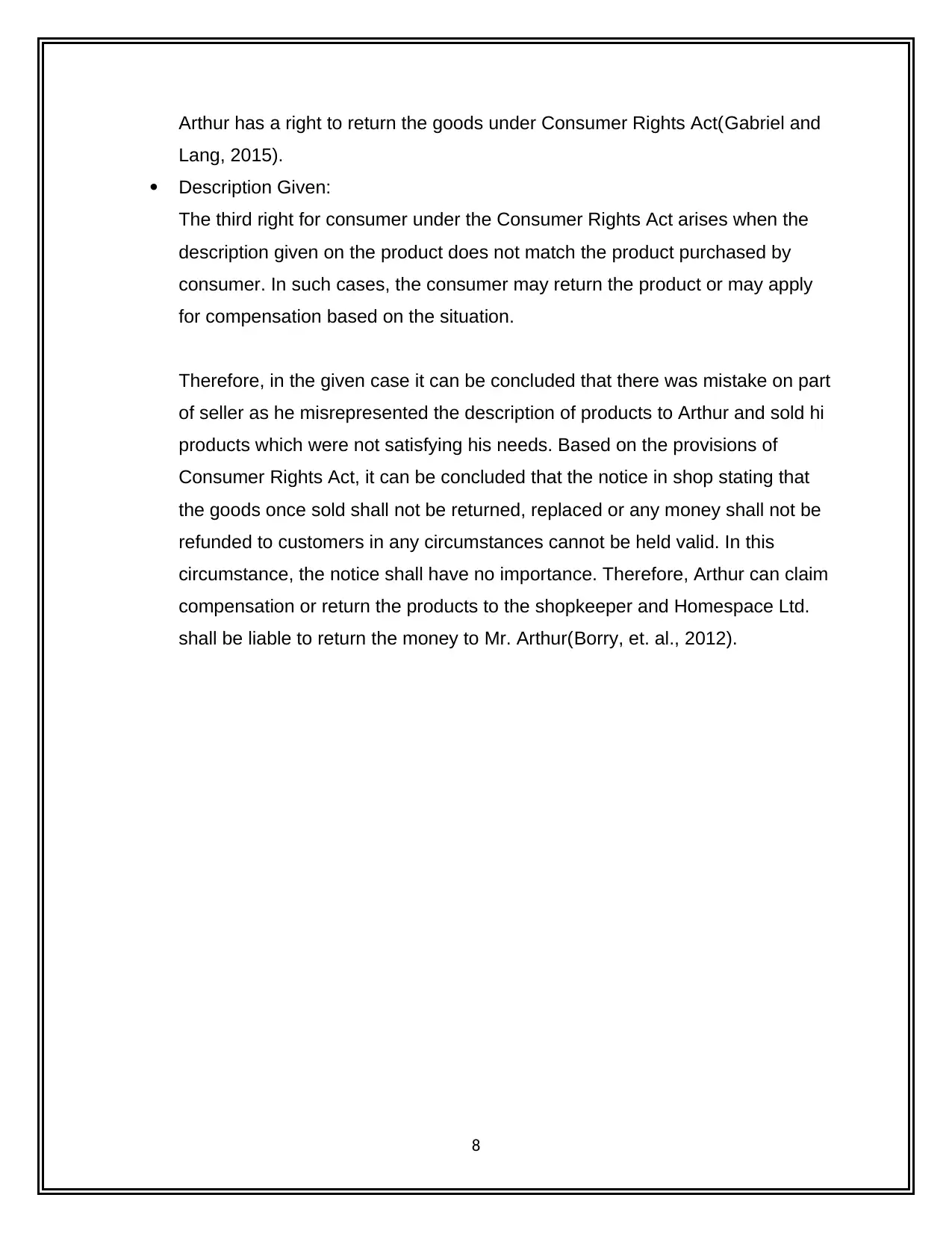
Arthur has a right to return the goods under Consumer Rights Act(Gabriel and
Lang, 2015).
Description Given:
The third right for consumer under the Consumer Rights Act arises when the
description given on the product does not match the product purchased by
consumer. In such cases, the consumer may return the product or may apply
for compensation based on the situation.
Therefore, in the given case it can be concluded that there was mistake on part
of seller as he misrepresented the description of products to Arthur and sold hi
products which were not satisfying his needs. Based on the provisions of
Consumer Rights Act, it can be concluded that the notice in shop stating that
the goods once sold shall not be returned, replaced or any money shall not be
refunded to customers in any circumstances cannot be held valid. In this
circumstance, the notice shall have no importance. Therefore, Arthur can claim
compensation or return the products to the shopkeeper and Homespace Ltd.
shall be liable to return the money to Mr. Arthur(Borry, et. al., 2012).
8
Lang, 2015).
Description Given:
The third right for consumer under the Consumer Rights Act arises when the
description given on the product does not match the product purchased by
consumer. In such cases, the consumer may return the product or may apply
for compensation based on the situation.
Therefore, in the given case it can be concluded that there was mistake on part
of seller as he misrepresented the description of products to Arthur and sold hi
products which were not satisfying his needs. Based on the provisions of
Consumer Rights Act, it can be concluded that the notice in shop stating that
the goods once sold shall not be returned, replaced or any money shall not be
refunded to customers in any circumstances cannot be held valid. In this
circumstance, the notice shall have no importance. Therefore, Arthur can claim
compensation or return the products to the shopkeeper and Homespace Ltd.
shall be liable to return the money to Mr. Arthur(Borry, et. al., 2012).
8

Conclusion
From the above scenario, it determines the right and duties of the consumer under the
consumer Rights Act, 2015. It also evaluates the remedies in case of breach of contract.
It also emphasis on the consumer rights Act, 2015.
9
From the above scenario, it determines the right and duties of the consumer under the
consumer Rights Act, 2015. It also evaluates the remedies in case of breach of contract.
It also emphasis on the consumer rights Act, 2015.
9
⊘ This is a preview!⊘
Do you want full access?
Subscribe today to unlock all pages.

Trusted by 1+ million students worldwide

References
Bloch, P.H., Bush, R.F. and Campbell, L., 1993. Consumer “accomplices” in
product counterfeiting: a demand side investigation. Journal of consumer
marketing, 10(4), pp.27-36.
Borry, P., Van Hellemondt, R.E., Sprumont, D., Jales, C.F.D., Rial-Sebbag, E.,
Spranger, T.M., Curren, L., Kaye, J., Nys, H. and Howard, H., 2012. Legislation
on direct-to-consumer genetic testing in seven European countries. European
Journal of Human Genetics, 20(7), p.715.
Bridge, M.G. ed., 2012. Benjamin's sale of goods (Vol. 11). Sweet & Maxwell.
Gabriel, Y. and Lang, T., 2015. The unmanageable consumer. Sage.
Ishak, S. and Zabil, N.F.M., 2012. Impact of consumer awareness and
knowledge to consumer effective behavior. Asian Social Science, 8(13), p.108.
Piscicelli, L., Cooper, T. and Fisher, T., 2015. The role of values in collaborative
consumption: insights from a product-service system for lending and borrowing
in the UK. Journal of Cleaner Production, 97, pp.21-29.
Ramsay, I., 2012. Consumer law and policy: Text and materials on regulating
consumer markets. Bloomsbury Publishing.
Weatherill, S., 2013. EU consumer law and policy. Edward Elgar Publishing.
10
Bloch, P.H., Bush, R.F. and Campbell, L., 1993. Consumer “accomplices” in
product counterfeiting: a demand side investigation. Journal of consumer
marketing, 10(4), pp.27-36.
Borry, P., Van Hellemondt, R.E., Sprumont, D., Jales, C.F.D., Rial-Sebbag, E.,
Spranger, T.M., Curren, L., Kaye, J., Nys, H. and Howard, H., 2012. Legislation
on direct-to-consumer genetic testing in seven European countries. European
Journal of Human Genetics, 20(7), p.715.
Bridge, M.G. ed., 2012. Benjamin's sale of goods (Vol. 11). Sweet & Maxwell.
Gabriel, Y. and Lang, T., 2015. The unmanageable consumer. Sage.
Ishak, S. and Zabil, N.F.M., 2012. Impact of consumer awareness and
knowledge to consumer effective behavior. Asian Social Science, 8(13), p.108.
Piscicelli, L., Cooper, T. and Fisher, T., 2015. The role of values in collaborative
consumption: insights from a product-service system for lending and borrowing
in the UK. Journal of Cleaner Production, 97, pp.21-29.
Ramsay, I., 2012. Consumer law and policy: Text and materials on regulating
consumer markets. Bloomsbury Publishing.
Weatherill, S., 2013. EU consumer law and policy. Edward Elgar Publishing.
10
1 out of 10
Related Documents
Your All-in-One AI-Powered Toolkit for Academic Success.
+13062052269
info@desklib.com
Available 24*7 on WhatsApp / Email
![[object Object]](/_next/static/media/star-bottom.7253800d.svg)
Unlock your academic potential
Copyright © 2020–2025 A2Z Services. All Rights Reserved. Developed and managed by ZUCOL.




